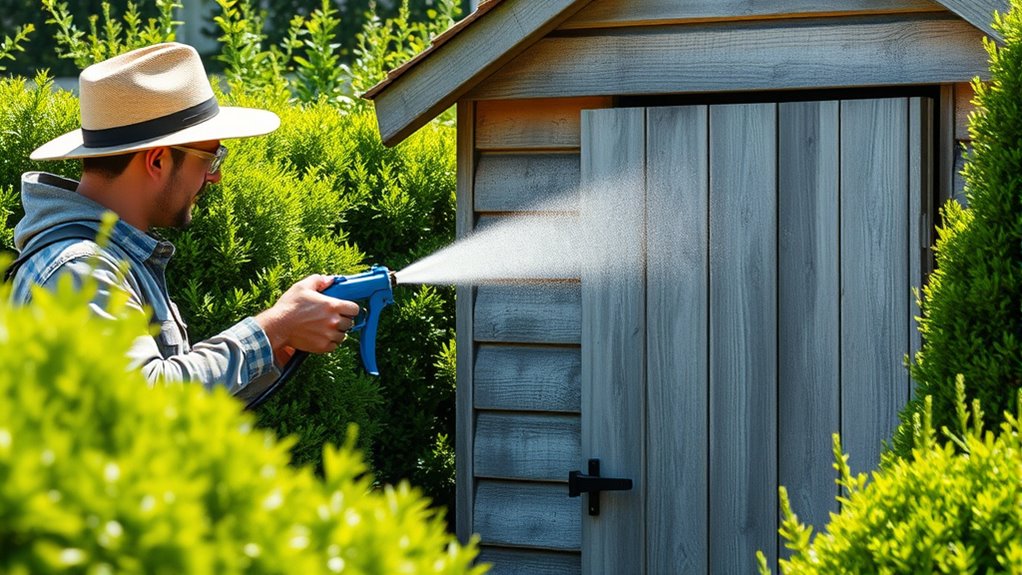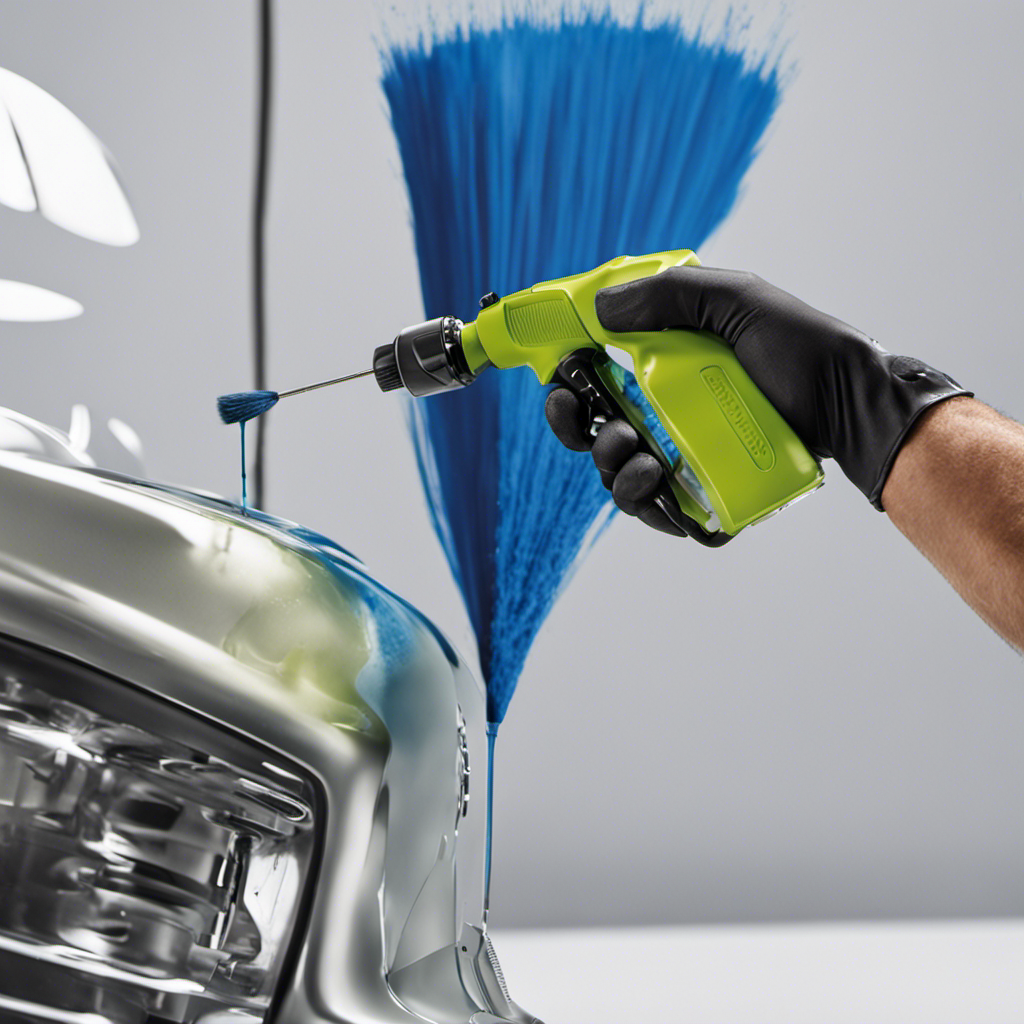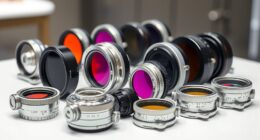To spray sheds and outbuildings effectively, select the right equipment like handheld or power sprayers based on your project size. Prepare your workspace by covering nearby plants and ensuring good ventilation. Always follow safety precautions, wear protective gear, and read chemical labels thoroughly. Calibrate your equipment for precise application and clean it well afterwards. If you keep these steps in mind, you’ll achieve a safe and thorough spray job—there’s more to learn for best results.
Key Takeaways
- Choose the appropriate spray equipment (handheld, backpack, or power sprayer) based on the shed’s size and treatment scope.
- Prepare the workspace by covering nearby plants and surfaces to prevent overspray contamination.
- Wear proper PPE, including gloves, goggles, long sleeves, and a mask or respirator, for safety during spraying.
- Follow chemical manufacturer instructions for mixing, application, and equipment calibration to ensure effective treatment.
- Clean equipment thoroughly after spraying and store chemicals securely, adhering to safety and disposal guidelines.

Spraying sheds and outbuildings is an efficient way to protect them from pests, mold, and weather damage. To do this effectively, you need to understand the different types of spray equipment available. There are handheld sprayers, backpack models, and larger electric or gas-powered sprayers. Handheld sprayers are lightweight and great for small areas or spot treatments, while backpack sprayers allow for more extensive coverage without requiring much physical effort. For larger projects, consider using power sprayers that can cover extensive surfaces quickly, saving you time and effort. Each type of equipment has its advantages, so choose based on the size of your shed or outbuilding and the scope of your treatment. Regardless of which you select, knowing how to operate it safely is vital.
Safety precautions should always be at the forefront when spraying. First, always read the labels and instructions on the chemicals you’re using. Many pesticides and sealants contain chemicals that can be hazardous if mishandled. Wear appropriate personal protective equipment (PPE), such as gloves, goggles, long sleeves, and a mask or respirator, to prevent skin contact and inhalation of fumes. Ventilation is also important; if possible, spray on a day with good airflow or in a well-ventilated area to disperse any fumes quickly. Before starting, check your equipment for leaks or damage, and ensure it’s properly calibrated to deliver the right amount of product. This not only guarantees effective coverage but also minimizes waste and potential over-application, which could pose health risks.
Handling chemicals responsibly also means preparing your workspace properly. Cover nearby plants, windows, or vents to prevent overspray from contaminating unintended areas. Keep a clean workspace and have water, soap, or an emergency wash station nearby in case of accidental spills or contact. Once you finish, thoroughly clean your spray equipment according to the manufacturer’s instructions to prevent clogs and maintain its longevity. Store chemicals in their original containers, away from children and pets, in a secure, dry place. Additionally, being aware of regional legal regulations can help ensure you are in compliance with local environmental and safety standards. By following these safety precautions and understanding the different types of spray equipment, you protect yourself, your property, and the environment. Proper preparation and responsible handling make the spraying process safer and more effective, ensuring your sheds and outbuildings are well protected from pests, mold, and weather damage.
Frequently Asked Questions
What Safety Gear Is Recommended for Spraying Sheds?
You should wear proper personal protective equipment, including gloves, goggles, a mask or respirator, and long-sleeved clothing to protect yourself from harmful chemicals. Make certain of good ventilation considerations by opening windows and doors, or using fans to circulate air. This helps reduce inhalation risks and exposure to fumes. Always follow the manufacturer’s safety instructions, and double-check your gear before spraying to stay safe and avoid health hazards.
How Do I Prepare the Surface Before Spraying?
Think of preparing your shed as setting the stage for a masterpiece. First, you’ll want to clean the surface thoroughly to remove dirt, mold, and loose paint—think of it as giving your shed a fresh start. Next, apply a primer to guarantee the paint adheres well and lasts longer. Proper surface cleaning and priming create a smooth, even base that makes your spraying job look professional and durable.
Can I Spray During Rainy or Humid Weather?
You shouldn’t spray during rainy or humid weather because it affects spray timing and application quality. Rain can wash away the coating, while high humidity slows drying and may cause uneven coverage. Check weather considerations carefully and wait for a dry, calm day to make certain of proper adhesion and curing. Planning your spray timing around favorable weather conditions guarantees a smooth, long-lasting finish on your shed or outbuilding.
How Often Should I Reapply the Protective Coating?
You should reapply the protective coating every 2 to 3 years to maintain best coverage and durability. Keep a regular maintenance schedule, inspecting your shed or outbuilding for signs of wear or damage. Proper reapplication extends the coating’s longevity, protecting your structure from moisture, pests, and weathering. By staying on top of recoating, you guarantee your shed remains well-protected and looks good for years to come.
What Types of Spray Equipment Are Best for Large Outbuildings?
For large outbuildings, airless sprayers are your best choice because they provide fast, even coverage. Look for models with adjustable spray tips to control the spray pattern and viscosity, ensuring a smooth application. Using the right spray tips helps prevent overspray and waste. Choose a sprayer with sufficient pressure and flow rate to cover large areas efficiently, making your project quicker and more professional-looking.
Conclusion
Now that you’ve learned how to spray your sheds and outbuildings, you’re armed with the tools to protect and preserve your space. Think of it as casting a shield of armor, warding off pests and decay. With each spray, you’re nurturing a sturdy fortress that stands resilient against the elements. So, grab your sprayer and take charge—your outbuildings will thank you, shining like a guardian’s castle, ready to serve for years to come.
Franz came aboard the Paint Sprayer Zone team with a background in both journalism and home renovation. His articulate writing style, combined with a passion for DIY projects, makes him an invaluable asset. Franz has a knack for breaking down technical jargon into easy-to-understand content, ensuring that even the most novice of readers can grasp the complexities of paint sprayers.










